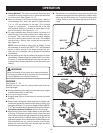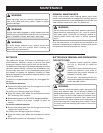
21
Replace the chain cover, washer and chain cover screw.
Tighten the chain cover screw finger tight only. The bar
must be free to move for tension adjustment.
Remove all the slack from the chain by turning the chain
tensioning screw clockwise until the chain seats snugly
against the bar with the drive links in the bar groove.
Lift the tip of the guide bar up to check for sag. Release
the tip of the guide bar and turn the chain tensioning
screw 1/2 turn clockwise. Repeat this process until sag
does not exist.
Hold the tip of the guide bar up and tighten the bar mount-
ing screw securely.
Chain is correctly tensioned when there is no sag on the
underside of the guide bar, the chain is snug, but it can
be turned by hand without binding.
NOTE: If chain is too tight, it will not rotate. Loosen the
chain cover screw slightly and turn tension adjuster 1/4
turn counterclockwise. Lift the tip of the guide bar up
and retighten chain cover screw securely. Assure that
the chain will rotate without binding.
Place the hex key back into the storage area.
Fig. 27
Fig. 28
hEX KEy
LIfT ThE TIp Of
ThE GuIDE BAR
up TO ChECK fOR
sAG
MAINTENANCE
CHAIN TENSION
See Figures 29 - 30.
Stop the engine before setting the chain tension. Make
sure the guide bar screw is loosened to finger tight, turn
the chain tensioner clockwise to tension the chain. Refer
to Replacing Bar and Chain earlier in this manual for
additional information.
A cold chain is correctly tensioned when there is no slack
on the underside of the guide bar, the chain is snug, but
it can be turned by hand without binding.
Chain must be re-tensioned whenever the flats on the
drive links hang out of the bar groove.
During normal saw operation, the temperature of the
chain will increase. The drive links of a correctly tensioned
warm chain will hang approximately .050 in. out of the
bar groove.
NOTE: New chain tends to stretch, check chain tension
frequently and tension as required.
CAUTION:
Chain tensioned while warm, may be too tight upon
cooling. Check the “cold tension” before next use.
AppROX. .050
in.
Fig. 30
fLATs
Fig. 29


















